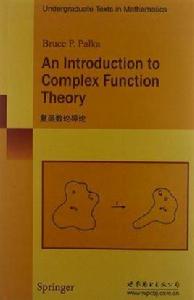內容介紹
《複函數論導論》內容簡介:自從20世紀60年代以來,高維複分析領域有了迅速發展。這個領域中的新老結果在分析、微分幾何和代數幾何方面得到了大量套用,特別是在當代數學物理中的套用。掌握高維複分析的基礎對許多現代數學領域中的專家來說已經成為了必需。
目錄
Preface
Ⅰ The Complex Number System
1 The Algebra and Geometry of Complex Numbers
1.1 The Field of Complex Numbers
1.2 Conjugate, Modulus, and Argument
2 Exponentials and Logarithms of Complex Numbers
2.1 Raising e to Complex Powers
2.2 Logarithms of Complex Numbers
2.3 Raising Complex Numbers to Complex Powers
3 Functions of a Complex Variable
3.1 Complex Functions
3.2 Combining Functions
3.3 Functions as Mappings
4 Exercises for Chapter Ⅰ
Ⅱ The Rudiments of Plane Topology
1 Basic Notation and Terminology
1.1 Disks
1.2 Interior Points, Open Sets
1.3 Closed Sets
1.4 Boundary, Closure, Interior
1.5 Sequences
1.6 Convergence of Complex Sequences
1.7 Accumulation Points of Complex Sequences
2 Continuity and Limits of Functions
2.1 Continuity
2.2 Limits of Functions
3 Connected Sets
3.1 Disconnected Sets
3.2 Connected Sets
3.3 Domains
3.4 Components of Open Sets
4 Compact Sets
4.1 Bounded Sets and Sequences
4.2 Cauchy Sequences
4.3 Compact Sets
4.4 Uniform Continuity
5 Exercises for Chapter Ⅱ
Ⅲ Analytic Functions
1 Complex Derivatives
1.1 Differentiability
1.2 Differentiation Rules
1.3 Analytic Functions
2 The Cauchy-Riemann Equations
2.1 The Cauchy-Riemann System of Equations
2.2 Consequences of the Canchy-Riemann Relations
3 Exponential and Trigonometric Functions
3.1 Entire Functions
3.2 Trigonometric Functions
3.3 The Principal Arcsine and Arctangent Functions
4 Branches of Inverse Functions
4.1 Branches of Inverse Functions
4.2 Branches of the pth-root Function
4.3 Branches of the Logarithm Function
4.4 Branches of the λ-power Function
5 Differentiability in the Real Sense
5.1 Real Differentiability
5.2 The Functions fz and fz
6 Exercises for Chapter Ⅲ
Ⅳ Complex Integration
1 Paths in the Complex Plane
1.1 Paths
1.2 Smooth and Piecewise Smooth Paths
1.3 Parametrizing Line Segments
1.4 Reverse Paths, Path Sums
1.5 Change of Parameter
2 Integrals Along Paths
2.1 Complex Line Integrals
2.2 Properties of Contour Integrals
2.3 Primitives
2.4 Some Notation
3 Rectifiable Paths
3.1 Rectifiable Paths
3.2 Integrals Along Rectifiable Paths
4 Exercises for Chapter Ⅳ
Ⅴ Cauehy's Theorem and its Consequences
1 The Local Cauchy Theorem
1.1 Cauchy's Theorem For Rectangles
1.2 Integrals and Primitives
1.3 The Local Cauchy Theorem
2 Winding Numbers and the Local Cauchy Integral Formula
2.1 Winding Numbers
2.2 Oriented Paths, Jordan Contours
2.3 The Local Integral Formula
3 Consequences of the Local Cauchy Integral Formula
3.1 Analyticity of Derivatives
3.2 Derivative Estimates
3.3 The Maximum Principle
4 More About Logarithm and Power Functions
4.1 Branches of Logarithms of Functions
4.2 Logarithms of Rational Functions
4.3 Branches of Powers of Functions
5 The Global Canchy Theorems
5.1 Iterated Line Integrals
5.2 Cycles
5.3 Cauchy's Theorem and Integral Formula
6 Simply Connected Domains
6.1 Simply Connected Domains
6.2 Simple Connectivity, Primitives, and Logarithms
7 Homotopy and Winding Numbers
7.1 Homotopic Paths
7.2 Contractible Paths
8 Exercises for Chapter Ⅴ
Ⅵ Harmonic Functions
1 Harmonic Functions
1.1 Harmonic Conjugates
2 The Mean Value Property
2.1 The Mean Value Property
2.2 Functions Harmonic in Annuli
3 The Dirichlet Problem for a Disk
3.1 A Heat Flow Problem
3.2 Poisson Integrals
4 Exercises for Chapter Ⅵ
Ⅶ Sequences and Series of Analytic Functions
1 Sequences of Functions
1.1 Uniform Convergence
1.2 Normal Convergence
2 Infinite Series
2.1 Complex Series
2.2 Series of Functions
3 Sequences and Series of Analytic Functions
3.1 General Results
3.2 Limit Superior of a Sequence
3.3 Taylor Series
3.4 Laurent Series
4 Normal Families
4.1 Normal Subfamilies of C(U)
4.2 Equicontinuity
4.3 The Arzelà-Ascoli and Montel Theorems
5 Exercises for Chapter Ⅶ
……
Ⅷ Isolated Singularities of Analytic Functions
Ⅸ Conformal Mapping
Ⅹ Constructing Analytic Functions
Appendix A Background on Fields
Appendix B Winding Numbers Revisited
Index

